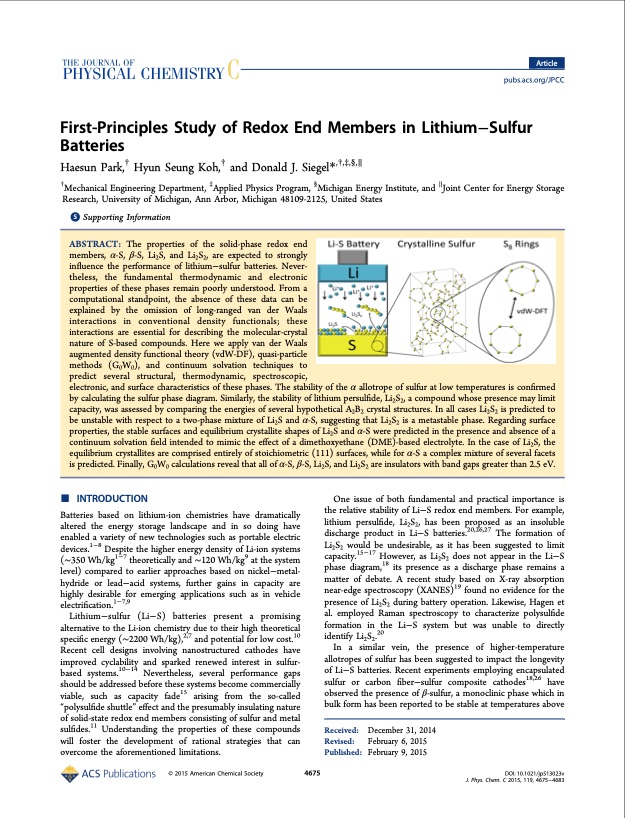
PDF Publication Title:
Text from PDF Page: 001
Article pubs.acs.org/JPCC First-Principles Study of Redox End Members in Lithium−Sulfur Batteries Haesun Park,† Hyun Seung Koh,† and Donald J. Siegel*,†,‡,§,∥ †Mechanical Engineering Department, ‡Applied Physics Program, §Michigan Energy Institute, and ∥Joint Center for Energy Storage Research, University of Michigan, Ann Arbor, Michigan 48109-2125, United States *S Supporting Information ABSTRACT: The properties of the solid-phase redox end members, α-S, β-S, Li2S, and Li2S2, are expected to strongly influence the performance of lithium−sulfur batteries. Never- theless, the fundamental thermodynamic and electronic properties of these phases remain poorly understood. From a computational standpoint, the absence of these data can be explained by the omission of long-ranged van der Waals interactions in conventional density functionals; these interactions are essential for describing the molecular-crystal nature of S-based compounds. Here we apply van der Waals augmented density functional theory (vdW-DF), quasi-particle methods (G0W0), and continuum solvation techniques to predict several structural, thermodynamic, spectroscopic, electronic, and surface characteristics of these phases. The stability of the α allotrope of sulfur at low temperatures is confirmed by calculating the sulfur phase diagram. Similarly, the stability of lithium persulfide, Li2S2, a compound whose presence may limit capacity, was assessed by comparing the energies of several hypothetical A2B2 crystal structures. In all cases Li2S2 is predicted to be unstable with respect to a two-phase mixture of Li2S and α-S, suggesting that Li2S2 is a metastable phase. Regarding surface properties, the stable surfaces and equilibrium crystallite shapes of Li2S and α-S were predicted in the presence and absence of a continuum solvation field intended to mimic the effect of a dimethoxyethane (DME)-based electrolyte. In the case of Li2S, the equilibrium crystallites are comprised entirely of stoichiometric (111) surfaces, while for α-S a complex mixture of several facets is predicted. Finally, G0W0 calculations reveal that all of α-S, β-S, Li2S, and Li2S2 are insulators with band gaps greater than 2.5 eV. ■ INTRODUCTION Batteries based on lithium-ion chemistries have dramatically altered the energy storage landscape and in so doing have enabled a variety of new technologies such as portable electric devices.1−8 Despite the higher energy density of Li-ion systems (∼350 Wh/kg1−7 theoretically and ∼120 Wh/kg9 at the system level) compared to earlier approaches based on nickel−metal- hydride or lead−acid systems, further gains in capacity are highly desirable for emerging applications such as in vehicle electrification.1−7,9 Lithium−sulfur (Li−S) batteries present a promising alternative to the Li-ion chemistry due to their high theoretical specific energy (∼2200 Wh/kg),2,7 and potential for low cost.10 Recent cell designs involving nanostructured cathodes have improved cyclability and sparked renewed interest in sulfur- based systems.10−14 Nevertheless, several performance gaps should be addressed before these systems become commercially viable, such as capacity fade15 arising from the so-called “polysulfide shuttle” effect and the presumably insulating nature of solid-state redox end members consisting of sulfur and metal sulfides.11 Understanding the properties of these compounds will foster the development of rational strategies that can overcome the aforementioned limitations. © 2015 American Chemical Society 4675 One issue of both fundamental and practical importance is the relative stability of Li−S redox end members. For example, lithium persulfide, Li2S2, has been proposed as an insoluble discharge product in Li−S batteries.20,26,27 The formation of Li2S2 would be undesirable, as it has been suggested to limit capacity.15−17 However, as Li2S2 does not appear in the Li−S phase diagram,18 its presence as a discharge phase remains a matter of debate. A recent study based on X-ray absorption near-edge spectroscopy (XANES)19 found no evidence for the presence of Li2S2 during battery operation. Likewise, Hagen et al. employed Raman spectroscopy to characterize polysulfide formation in the Li−S system but was unable to directly identify Li2S2.20 In a similar vein, the presence of higher-temperature allotropes of sulfur has been suggested to impact the longevity of Li−S batteries. Recent experiments employing encapsulated sulfur or carbon fiber−sulfur composite cathodes18,26 have observed the presence of β-sulfur, a monoclinic phase which in bulk form has been reported to be stable at temperatures above Received: December 31, 2014 Revised: February 6, 2015 Published: February 9, 2015 DOI: 10.1021/jp513023v J. Phys. Chem. C 2015, 119, 4675−4683PDF Image | First-Principles Study of Redox End Members in Lithium Sulfur

PDF Search Title:
First-Principles Study of Redox End Members in Lithium SulfurOriginal File Name Searched:
JPCC_Li-S.pdfDIY PDF Search: Google It | Yahoo | Bing
Sulfur Deposition on Carbon Nanofibers using Supercritical CO2 Sulfur Deposition on Carbon Nanofibers using Supercritical CO2. Gamma sulfur also known as mother of pearl sulfur and nacreous sulfur... More Info
CO2 Organic Rankine Cycle Experimenter Platform The supercritical CO2 phase change system is both a heat pump and organic rankine cycle which can be used for those purposes and as a supercritical extractor for advanced subcritical and supercritical extraction technology. Uses include producing nanoparticles, precious metal CO2 extraction, lithium battery recycling, and other applications... More Info
| CONTACT TEL: 608-238-6001 Email: greg@infinityturbine.com | RSS | AMP |